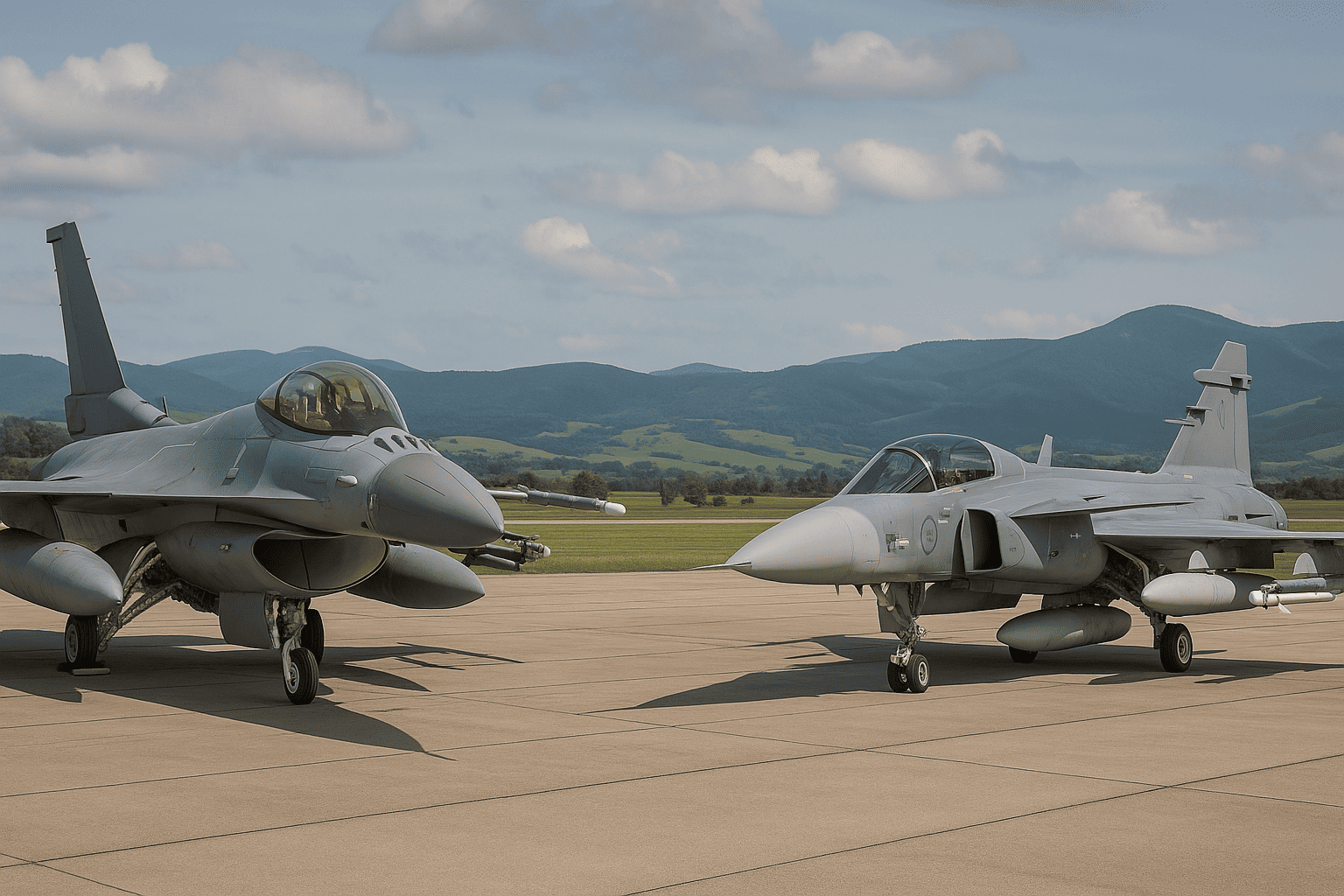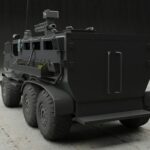Slovakia has reached the point of decision after more than a decade of debate over its MiG-29 replacement. Formal offers now sit on the defence minister’s desk from two camps: Lockheed Martin with the F-16V Block 70/72 and Sweden’s Saab with the Gripen C/D. The ministry aims to brief the cabinet by 29 June and secure approval before Parliament rises for its summer recess.
The American bid arrived in Bratislava on 10 April inside a complete Letter of Offer and Acceptance. It covers fourteen single-seat F-16Vs, support equipment, training, and weapons. Lockheed’s recent deal to supply Egypt with 20 new F-16s shows the company’s momentum in the region and underscores the appeal of the Block 70/72 configuration among emerging air forces. Lockheed stresses that the package mirrors government-to-government deals already executed in Europe, promising first delivery in 2022 if Slovakia signs this year.
Saab’s counter-proposal leans on speed and familiarity. Gripen airframes roll off an active production line, and Sweden offers to lease aircraft from its own air force so that Slovak pilots can start conversion within two years. The company also highlights lower operating costs and an offset plan that would channel avionics work to the state plant at Trenčín.
Outdated MiG-29 Fleet and Strategic Pressure on the Slovak Air Force
Twelve MiG-29s remain on the Slovak inventory, yet barely a third can fly at any one time. The jet’s twin Tumansky engines burn fuel fast and need Russian overhaul support, a dependency that Bratislava wants to end. The MiG maintenance contract expires in December 2019, leaving a tight hand-over window no matter which Western type wins.
Cost drives the contest. A U.S. Defense Security Cooperation Agency notice on 4 April set an upper ceiling of $2.91 billion for the F-16 package, including missiles and spares. Slovak officials argue that the actual figure runs closer to €1.5 billion because the ministry can trim non-essential extras.
Swedish prices remain private, but leaked Czech leasing data give an anchor. Prague pays about €50 million per year for fourteen Gripens, a rate that includes training, depot visits, and 1,700 flight hours. Saab tells lawmakers that a direct purchase beats those lease totals over a twenty-year span, yet firm numbers stay off the record.
Capability Comparison: F-16V vs Gripen for the Slovak Air Force Modernization
Capability still matters. The F-16V adds the AN/APG-83 AESA radar, a sensor that can track small targets while resisting jamming. Gripen C uses the mechanically-scanned PS-05/A Mk 4, though Saab argues software boosts offset the hardware gap. Both jets carry AIM-120 AMRAAM and IRIS-T or AIM-9X dog-fight missiles, and both accept smart bombs. Where they diverge is power: the F-16’s F110-GE-132 produces 29,000 lbf, almost sixty per cent more than the Gripen’s RM12. More thrust brings heavier payloads and faster climbs, but it also burns extra fuel.
Lockheed’s brochure spells out the hardware on the table:
- 14 × F-16V Block 70/72 airframes
- AN/APG-83 AESA radars in every nose
- AIM-120C-7 and AIM-9X missile stock
- Sniper targeting pods
- Guidance kits for JDAM and Paveway bombs
- Simulators, spares, and a five-year training syllabus
Sweden counters with a leaner fit-out that focuses on readiness:
- 12 × Gripen C plus 2 × Gripen D trainers
- PS-05/A Mk 4 radars with synthetic-aperture mapping
- IRIS-T and MBDA Meteor integration rights
- A turnkey lease or a direct-buy option
- Industrial work at LOT Trenčín for wiring looms and avionics boxes
Flight-hour cost remains Saab’s strongest card. Jane’s figures put the Gripen close to $4,700 per hour. The U.S. Air Force pegs its F-16Cs around $7,000, while a broader Pentagon audit that folds in manpower and depot work pushes the number above $20,000. Lockheed replies that Block 70 engines and digital maintenance cut those legacy costs, and that the airframe’s certified 12,000-hour life spans far longer than the Gripen’s baseline 8,000.
Industrial ties play a role in a country of five million people. Lockheed offers simulator hubs at Sliač and a path into the global F-16 sustainment pool. Saab promises software labs on Slovak soil and points to smooth cooperation with the Czech Air Force. Either path frees Bratislava from Russian logistics, and both promise NATO-standard datalinks from day one.
A scoring board created by the ministry assigns thirty per cent weight to acquisition price, thirty per cent to long-term cost, twenty-five per cent to combat capability, and fifteen per cent to delivery schedule. Early cabinet leaks hint at a tight race, with the F-16 rated stronger on sensors and resale value, and the Gripen topping the charts on cost and speed. The contentious nature of high-profile procurement competitions, like the MD Helicopters’ challenge to a LUH contract award, echoes the political pressures Slovakia now faces in finalizing its choice. The final call rests with Defence Minister Peter Gajdoš, who must brief the cabinet by the end of June.
Analysts note that either jet meets NATO’s air-policing task. The debate instead pivots on budget headroom and risk. If Slovakia selects the F-16, it faces at least three years of gap coverage, likely handled by the Czech Air Force. Should it choose the Gripen, deliveries might arrive soon enough to dodge a MiG-29 contract extension, saving a projected €200 million that would be needed to keep the Russian jets airworthy.
Lockheed’s sales team tells reporters that the first four F-16Vs would ferry in 2022, giving local engineers time to refurbish shelters and fuel farms. Saab claims it can fly a pair of Swedish Gripens to Sliač within twenty-four months of a signature, then roll in new-build aircraft off the line in Linköping.
Slovakia’s choice also signals its strategic leaning. Neighbours Bulgaria, Romania, and Poland all operate F-16s. Hungary and the Czech Republic form a mini-Gripen club. By joining the F-16 group, Slovakia is further aligning itself with regional partners like the Netherlands, which recently expanded their own next-gen fighter fleets. Joining either group would shape training exchanges and spare-part stockpiles. The cabinet decision, weeks away, therefore carries weight far beyond the immediate price tag.
The political clock ticks. Parliamentary party leaders want clarity before campaigning starts for municipal elections in the autumn. Voters remain wary of headline defence sums, yet opinion polls after Russia’s actions in Ukraine show rising support for NATO investment. Ministers hope a transparent process and clear cost breakdowns will quell fears of graft that dogged earlier tenders.
Lockheed Martin Completes First Two F-16s for Slovakia – March 2025 Update
Slovakia chose the F-16V on 11 July 2018 after a twelve-to-three cabinet vote. Parliament approved the €1.6 billion contract on 12 December 2018, bundling fourteen Block 70 jets, weapons, simulators, and a decade of support. The COVID-19 pandemic closed factories and slipped the schedule. Lockheed’s Greenville line lost three months, then suffered engine supply delays. The first acceptance flight finally lifted in January 2024 at Edwards Air Force Base. Two jets stayed in Arizona for pilot conversion until infrastructure upgrades in Slovakia caught up.
On 22 July 2024 the first pair of F-16Vs landed at Kuchyňa Air Base, escorted by Czech Gripens in a low-level salute. The arrival of Slovakia’s first F-16 Block 70 jets marked a new era in its air defense capability. The arrival ended a year of reliance on Czech and Polish patrols that filled the gap after Slovakia donated its remaining MiG-29s to Ukraine in March 2023.
Three more aircraft ferried in on 2 April 2025, raising the local fleet to five. Two additional jets have completed acceptance flights but stay in the United States for software loads, while the remaining seven sit on Greenville’s final-assembly line. Pratt & Whitney faces tight delivery slots for F100 engines, yet Lockheed insists all fourteen aircraft will reach Slovakia before 2026.
Training keeps pace. Thirteen pilots finished the basic syllabus at Luke Air Force Base by February. They now embed with the 309th at Holloman, flying U.S. F-16Cs until local conversion units start at Sliač. The first cadre of sixty maintainers graduated from Sheppard AFB in October 2024 and returned home to stand up the new logistics squadron.
Budget lines widened. Inflation, depot tooling, and a fresh missile buy lifted life-cycle cost projections to €9.8 billion. Opposition lawmakers push for phased payments, but none call for cancellation. The defence ministry eased pressure by splitting weapons procurement: an initial lot of thirty-six AIM-120D missiles arrived in February, with follow-on orders tied to future budgets.
Early operational assessments from NATO exercise Ram Shield look good. The first two Slovak F-16Vs flew quick-reaction sorties, and radar recordings show they tracked targets almost twice as far as the old MiG-29 sensors and slightly beyond Czech Gripen ranges. March trials at the Greek Test Range saw Slovak pilots fire AIM-9X missiles for the first time, scoring direct hits on QF-4 drones.
Industry offsets turn tangible. Raytheon and Lockheed co-financed an avionics lab at LOT Trenčín that opened in January 2025. The centre loads software for Slovak and Croatian F-16 fleets and employs eighty specialists. A second phase, set for 2026, will add radar-test benches.
Politics shifted when Robert Fico returned as prime minister in September 2024. His coalition halted state weapons aid to Kyiv but left the F-16 programme untouched, calling it a “done deal that shields Slovak airspace for decades.” Speculation about slowing deliveries faded after his first security-council meeting upheld the timeline.
Saab did not close its Bratislava office. The Swedes now market the GlobalEye airborne early-warning jet as a partner for the F-16 fleet, pitching common data links and delivery from 2028. Defence officials confirm informal talks yet no stated requirement.
The air force targets initial operational capability late in 2025. That milestone needs eight jets on Slovak soil, eighteen qualified pilots, and full Link-16 ties to NATO’s Combined Air Operations Centre in Uedem. Full operational capability should follow in 2027 once the final weapon stocks arrive and hardened shelters reach completion.
REFERENCE SOURCES
- https://www.reuters.com/world/europe/slovakia-gets-first-new-f-16s-boost-air-defence-2024-07-22/
- https://www.defensenews.com/digital-show-dailies/riat/2018/07/11/slovakia-selects-f-16-over-gripen-for-new-fighter/
- https://www.dsca.mil/press-media/major-arms-sales/slovak-republic-f-16-block-7072-aircraft
- https://thedefensepost.com/2018/11/30/slovakia-f-16-contracts-signed-pm-says-invalid/
- https://www.reuters.com/world/slovakia-get-new-f-16-fighter-jets-year-later-2022-03-10/
- https://www.defensemirror.com/news/35814/Slovakia_to_Soon_Become_First_European_Nation_to_Operate_F_16_Block_70_Aircraft
- https://thedefensepost.com/2019/08/01/lockheed-slovakia-f-16-contract/
- https://www.czdefence.com/article/acquisition-of-f-16-fighters-for-the-slovak-army-the-first-pilots-are-already-training-in-the-usa
- https://news.lockheedmartin.com/2024-7-22-Lockheed-Martin-and-Slovakia-Usher-in-New-Era-of-European-Air-Defense-with-Arrival-of-First-F-16-Block-70-Jets
- https://thedefensepost.com/2025/04/04/slovakia-f16-vipers/



